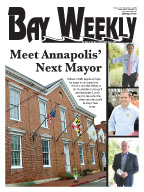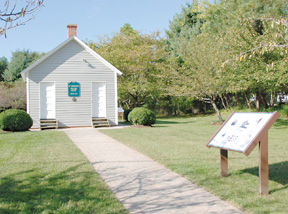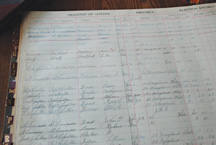
Chesapeake Bay's Independent Newspaper ~ Since 1993
1629 Forest Drive, Annapolis, MD 21403 • 410-626-9888
Volume XVII, Issue 44 ~ October 29 - November 4, 2009
Home \\ Correspondence \\ from the Editor \\ Submit a Letter \\ Classifieds \\ Contact Us
Dining Guide \\ Home & Garden Guide \\ Archives \\ Distribution Locations \\ Advertising
![]()

A Community Honors Its History
Stories of voters, presidents and first ladies told at the St. Leonard Polling House

by Sandra Lee Anderson
Inside the Polling House, next to the pot-bellied stove, Dotty Greene wore polyethylene gloves to gently turn the pages of the Voter Registration Book for 1919-1930 to the Ws, to find her father’s name, Leroy Williams. “Look,” she called to her sister, Nancy Zinn. “There’s Aunt Gussie.”
Under Greene’s hands, the voter registration book spread the width of the table. Each entry extends across both pages, listing name, address, race and literacy.
The registration book was opened for the dedication of two interpretive signs commemorating the historic Polling House and, behind it, the Garden of Remembrance. The signs were the project of the St. Leonard Vision Group and member Fred Dellinger and funded by a Maryland Heritage grant.
The Polling House, a little gray building with two doors, stands a block south of St. Leonard’s traffic circle, on the west side of Route 765. It was built in 1926, used until 1974, restored in 1984 and, in 1993, made a State Historical Landmark and centerpiece of St. Leonard’s Garden of Remembrance Park.
Voters and Builders
The Polling House sign recalls many chapters of history. Voters in St. Leonard, Wallville, Mutual, Broome’s Island, Scientists Cliffs and Port Republic filed into the St. Leonard Polling House through the in door on the left and filed out via the out door on the right. On voting day in the 1920s, Johnny Ward “kept people going in and out the right door,” Greene recalled.

![]() Between 1920 and 1970, registered voters changed from predominantly African American to white and from Republican to Democrat. The earlier African Americans belonged to Lincoln’s Republican party.
Between 1920 and 1970, registered voters changed from predominantly African American to white and from Republican to Democrat. The earlier African Americans belonged to Lincoln’s Republican party.
Builders as well as voters are remembered in the new signs. Thomas Parran, member of the House of Representatives, purchased the lumber to build this new Polling House, replacing an earlier polling house now moved to his Windmill Farm farther south on the east side of Route 765.
The farm’s namesake windmill, still visible, was installed to accommodate William Howard Taft, president from 1909 to 1913 and Parran’s friend. For the presidential visits, the Parrans built a private bathroom. The windmill drew water to flush the toilet.
Norman A. Gray, an African American contractor, built the Polling House and several school buildings, including some of Calvert’s one-room schools.
Fond Farewells and First Ladies
The second interpretive sign tells the story of the Garden of Remembrance. In the late 1980s, Route 2/4 was completed as a divided four-lane highway. With no traffic lights, at least four people died at the St. Leonard intersections within 18 months, including Dr. Roberto De Villareal. Dr. V, a Colombian, had served the community for 40 years, accepting whatever payment his patients could give.
Led by Nancy Zinn and Marie Andrews, the St. Leonard group planted the Garden of Remembrance in 1990 to honor those who had died on Route 2/4. Horticultural designer Mary Alves laid out the garden’s hourglass-shaped path past cherry and golden rain trees, butterfly bushes, white roses and fragrant herbs.
Visitors can rest on benches beside gardens named for presidential wives whose families lived in St. Leonard:
Mrs. John Quincy Adams was the niece of Thomas Johnson, Maryland’s first governor and namesake of the tall bridge on Route 2/4 linking Calvert County with St. Mary’s County. Following President Adam’s presidency, 1825-1829, the couple worked with anti-slavery and women’s rights movements.
Mrs. Zachary Taylor grew up on the family’s tobacco plantation next to St. Leonard Creek. She spent her first married years with then Lt. Zachary Taylor on the frontier, where she worked with the sick and taught children at the forts. When President Taylor died, the couple had lived in the White House for only two years, 1849 to 1850.
Visit the Garden of Remembrance, Polling House and interpretive signs that place them in human history at any time, with the registration book opened by appointment with Fred Dellinger: [email protected].
© COPYRIGHT 2009 by New Bay Enterprises, Inc. All rights reserved.